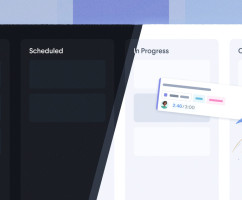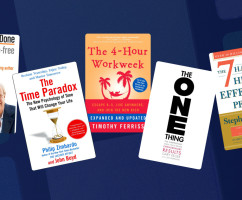We’ve all been there. We pour our morning cup of coffee, sit down in our nice comfortable desk chair, open the laptop and begin to focus on the task at hand. It’s 9:30 am, you’ve got a coffee buzz, and you’re sure you’re going to knock this thing out in 90 minutes or less.
But the inevitable happens. You forgot to put your phone on DND and your email app is still open from last night. The text from your partner comes in - “You forgot to feed the dog”, the email sound pings and you see invoices that need to be paid.
You think, “yes let me just do those other tasks quickly and then I can get back to task A”. Before you know it your attention has spilled over to the two other tasks you just gave yourself and now you find it hard to go back and write that blog post, or design that flyer.
What happened is your attention left residue in tasks B, and C, and maybe D and E! Now it’s even harder to bring your full attention back to task A as a result.
What is Attention Residue?
The original term ‘attention residue’ was coined by a business professor named Sophie Leroy who has studied the brain for over 17 years in the area of constantly switching focus. She says:
"Attention residue easily occurs when we leave tasks unfinished, when we get interrupted, or when we anticipate that once we have a chance to get to the unfinished or pending work we will have to rush to get it done. Our brain finds it hard to let go of these tasks, and instead keeps them active in the back of our mind, even when are trying to focus on and perform other tasks.”
Leroy mentions in particular the notion that when we leave task A, to go to task B, we still have some residual focus left in task A because our brains don’t deem it to be completely ‘finished’. Therefore task B doesn’t get the same amount of attention as Task A, and on it goes.
Cal Newport, who also has also done a great deal of study in this area with his book Deep Work, likens it to someone who plays the classic arcade game Snake. This is an old-school game from the 80s and 90s where you have to move your snake around and eat apples without crashing into yourself (Zoomers won’t get it, but that’s ok). At first, the gamer does well, but once distractions happen and they pause the game, they often end up performing less well and crashing their snake on resumption because of attention residue.
Not only does attention residue or ‘context switching’ occur when moving from task A to task B, as Leroy details in her paper, but it can also be an issue when moving from task B back to task A (with task B being the lesser important task or distraction). Either way, this switching between contexts hurts our productivity and isn’t good for those single-tasking, especially knowledge workers.
So How do we Combat Attention Residue?
It’s worth noting that Attention Residue is not necessarily a bad thing. The idea that our brains are still concerned with the prior task when moving on to a new task shows us that we want to make sure we’ve completed the first task successfully and haven’t missed anything. If anyone has studied the Enneagram then they will understand this behavior fits a Type One perfectly!
However, when trying to complete a task efficiently in the least amount of time possible with the best quality possible, it’s something we should try to minimize in our workday.
So what should we do?
Apart from the obvious ‘do not disturb’ mode, a good start to combating the attention residue effect is proper time planning, which is what we are all about at HourStack.
Focused Time Blocks
In a recent post, we talked about focused time blocks including a study that shows how students were more effective at learning when working in a 90-minute window with a 20-30 minute rest.
Generally speaking, the time blocking method is going to be your friend when it comes to making the most out of the hours in your workday. In HourStack we encourage you to block out or allocate time for your tasks by dragging the task over to your workday and then dragging out the amount of time you want to spend (e.g. 90 minutes). During that time make sure you have in fact eliminated as many distractions as you can. The shorter the time window, the less likely you will get distracted.
A note on productivity cycles
It’s worth studying how long your productivity cycles last. Research shows that 90-120 minutes is the norm, but for some, it could be as short as 60 minutes. Make sure you start a timer when you begin your task, and make sure you pause it when you are starting to slow down and feel like you need a break. This will help you when you run reports to find out what your average productivity time block looks like.
Don’t Over-plan
We often want to get everything done all in one day, but let's be honest with ourselves and know that we just can’t do it all (or at least we can’t do it all really well). It’s better to do less and do it better than do more and do it worse. If we can achieve one or two blocks of focused time in our workday without distraction or context switching, we will be doing a good job of combating the negative effects of attention residue. That all boils down to how you plan out your workday, in particular your single-task work.
Make the Commitment
Maybe you did the opposite of over-planning and have just one task you want to get done in two hours. If that’s the case, commit to it. Find the best time of the day based on your own circadian rhythm where you know you will be at peak performance, and commit to starting and finishing that task without distractions.
It will mean preparing mentally for that task and making sure you’ve done things like putting your phone in another room, shutting the door, and even making sure you’ve had a snack (hangry does not equal productivity).
There is a lot of science behind making commitments, especially within the context of behavioral consistency, which shows that when you commit to working on a task you are more likely to follow through with it.
"Once we have made a choice or taken a stand, we will encounter personal and interpersonal pressures to behave consistently with that commitment. Those pressures will cause us to respond in ways that justify our earlier decision." -Robert Cialdini
Consider ‘Microbreaks’
Have you heard of Decision Fatigue? In a both famous and very interesting study, a group of judges was found to be more likely to grant parole to prisoners after taking lunch breaks than when working long hours without a break. In fact, the rate of parole getting granted dropped to almost 0% in cases where very long stretches of hours were worked, simply because it’s easier to make one simple decision of “no” as a result of decision fatigue.
Breaks are important, and we probably all know that. A good two-hour productivity cycle includes a 30-minute break to achieve maximum performance. But what if we broke that down into even smaller breaks, with perhaps a shorter block of focus time? This technique has been labeled ‘microbreaks’ and is basically a 10-15 minute step away from whatever you are working on.
If you use a standing desk then you might already be familiar with this, as it’s very easy to just walk away from your work when standing up than it is to get up from your comfy chair. The science on ‘walking away’ and coming back to your task is pretty clear as documented in this (actually pretty scary) study from 2013 about surgeons who perform better after taking a microbreak. So maybe consider how you can implement this productivity hack into your workday.
Don’t be Afraid to Reset
It happens, we get distracted, and we sometimes put out work that’s not our best, and feel disheartened later when we look back at it. Don’t be afraid to reset after taking a break. Maybe even start again and have another go at the task within a new focused time block. You’ll be amazed at what you can accomplish with a task when coming back to it after a day or two.
A reset gives your brain a chance to clear out any attention residue so you can come back to task A with a completely fresh focus.
If you find that you’re at the point where you don’t have the time to do a reset, that’s ok, just be sure that next time you’re planning your tasks you leave plenty of time (days or even weeks) before the due date to allow for resets which will inevitably happen because we’re human after all.
Try HourStack for Your Attention Residue Counteroffensive
If you haven’t already started a free 14-day trial with HourStack, sign up on our website. We’ll be glad to coach you on how you can use HourStack for more efficient time blocking, scheduling, time tracking, and reporting.
We may never be able to completely eliminate the negative effects of attention residue and context switching, but we can certainly provide you with the tools to help you make the most out of the hours in your workday by using HourStack—so give it a try!
Updated March 28, 2023 in Tips & Tricks






